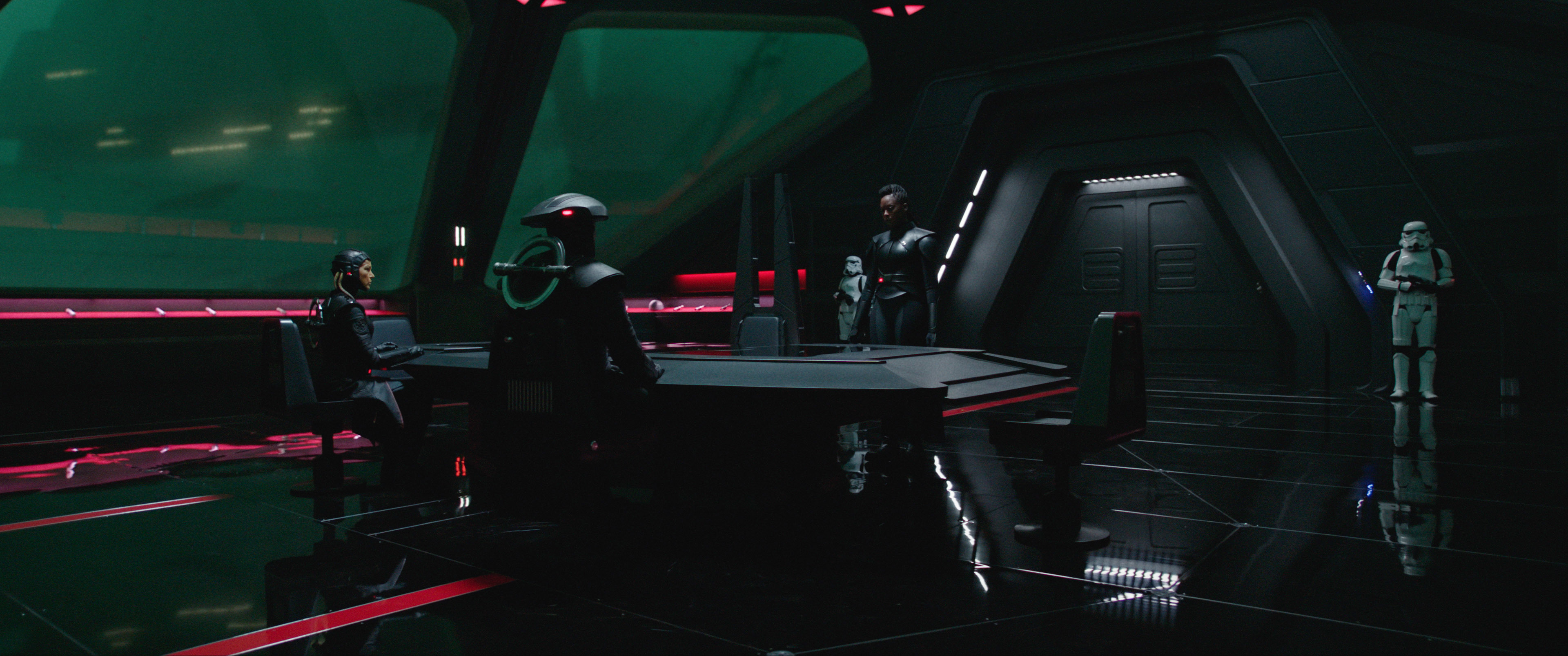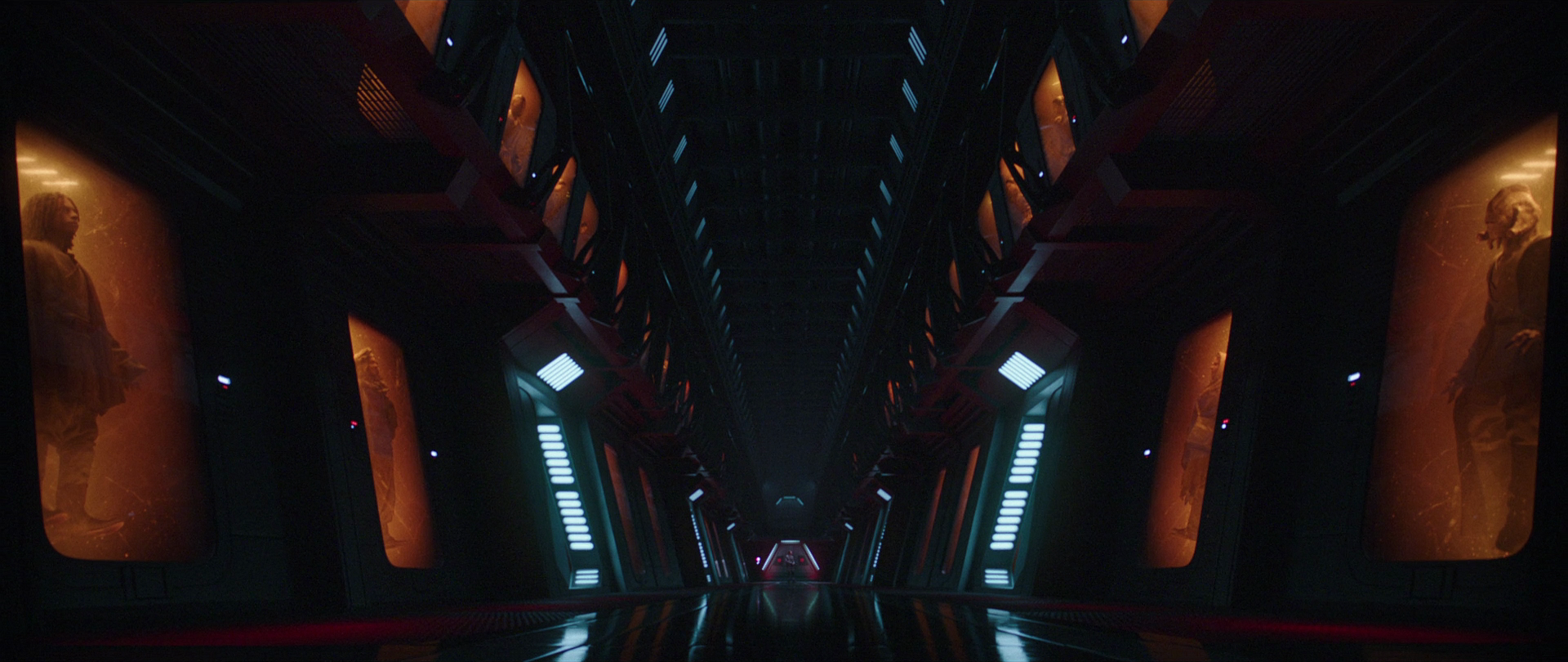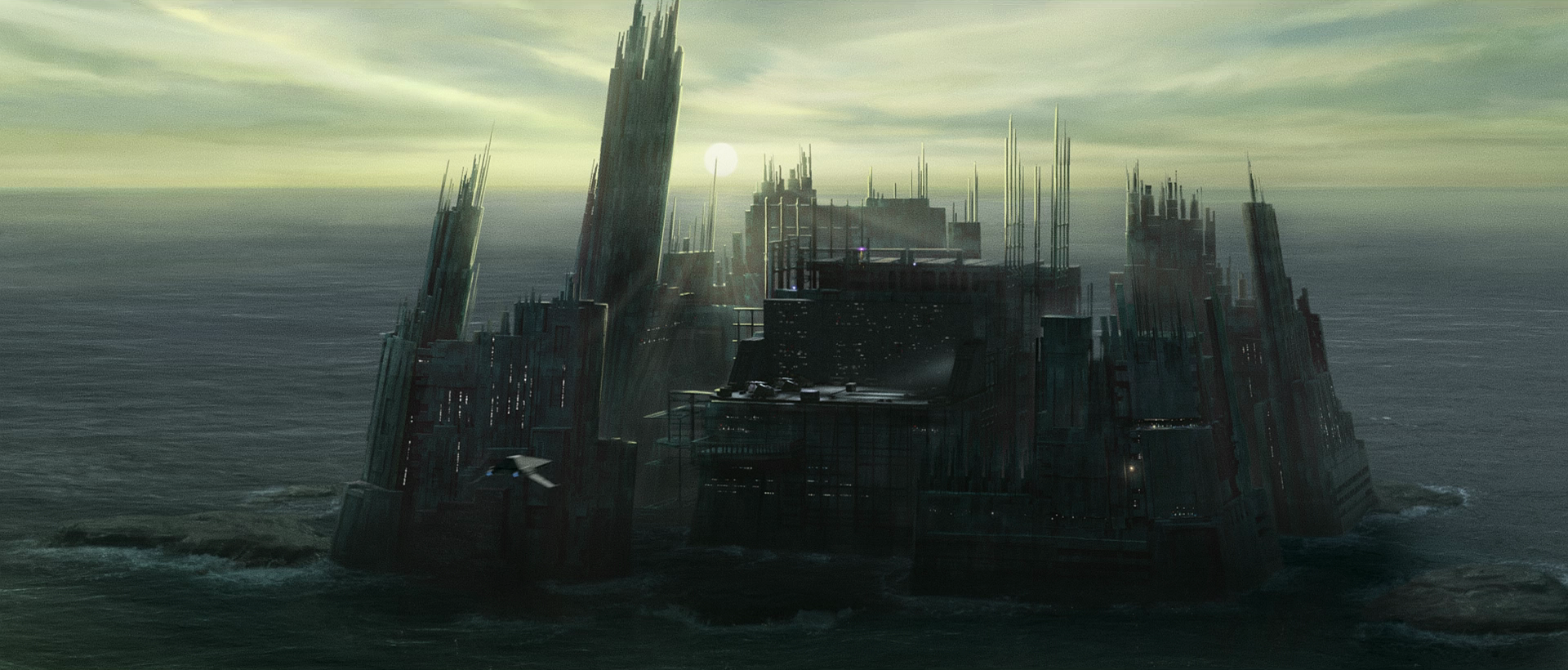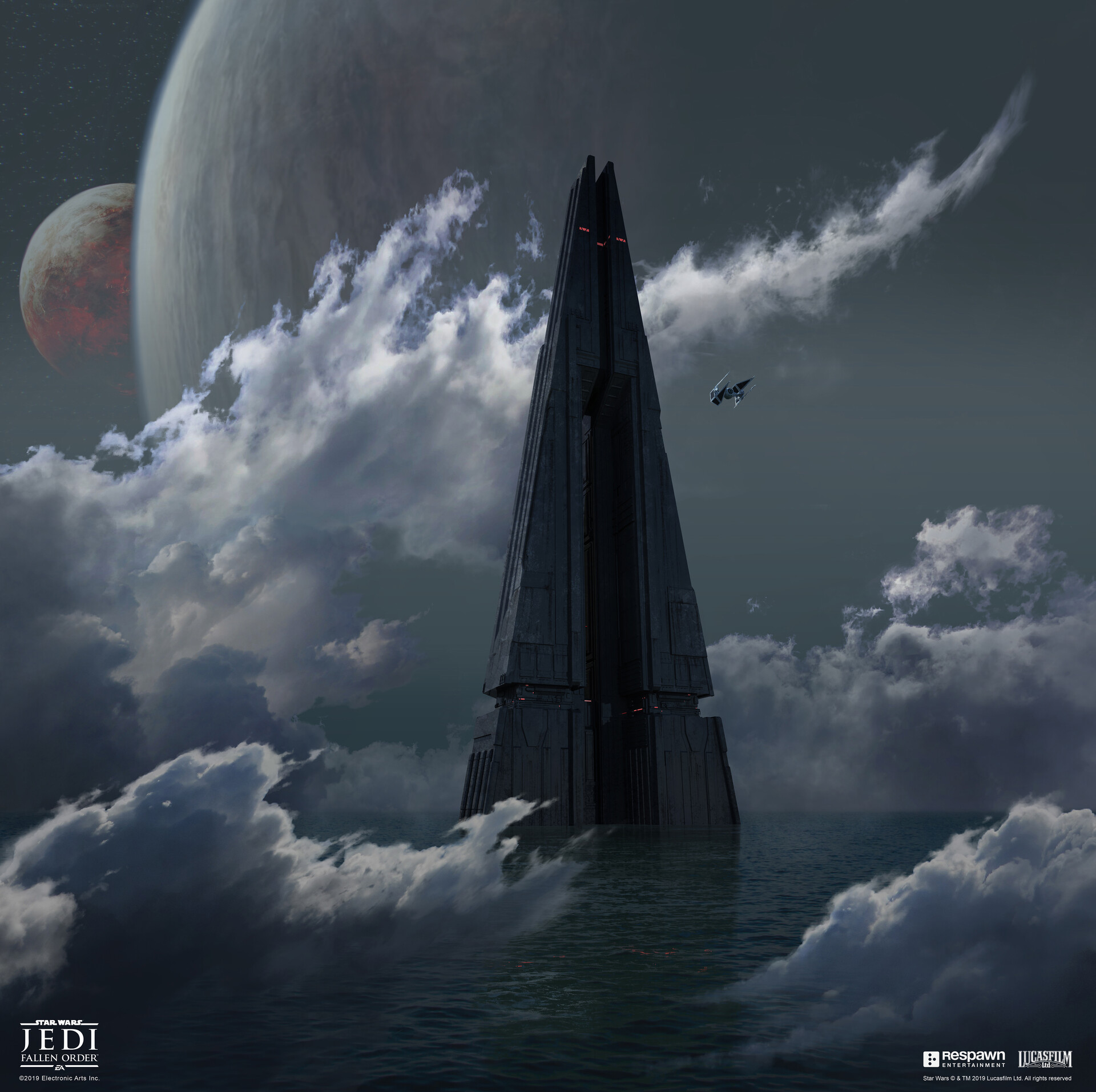Fortress Inquisitorius was a heavily armed underwater stronghold concealed within the black seas on the shadowy moon Nur. The stronghold served as the central seat of the Imperial Inquisitor Program after they were moved off their previous headquarters on Coruscant due to the rogue Inquisitor chase. The existence of the fortress was hidden from the majority of the Empire to maintain the public perception of peace and security. In reality, it was where the Empire took the Jedi they captured and turned them to the dark side by brutal torture turning them into Inquisitors. However, the Imperials were unable to corrupt all of them. In 14 BBY, during the Great Jedi Purge, a mission took place at the fortress by the Jedi Cal Kestis and Cere Junda, resulting in the execution of the Second Sister by Darth Vader.
The Fortress Inquisitorius was mostly below sea level and consisted of a Defensive Perimeter around the outer sections, a prison block for detaining captured Jedi and other force-sensitives and a citadel tower that was at the center of the fortress. The fortress was protected by shields controlled by a multi-shield system that could be compromised or disabled. However according to Kawlan Roken the stronghold was unshielded as the Inquisitors believed no one would be stupid to attack it. The fortress was also heavily armed with turbolasers that could protect the stronghold from attack.
The security systems within the Fortress are a complex network controlling bridges, wings, gates and portals. By employing a multi-tier-fail-safe structure, the Empire controls every corner of the facility, providing immediate response to any breach. If necessary, the entire fortress may be purposely compromised or flooded to prevent the escape of prisoners.
The citadel tower was at the center of the fortress and towered over the rest of it with the top of the tower being the only part of the fortress that was above sea level. Located at the top of the tower were hangar bays that stretched around the tower and had Lambda-class T-4a shuttles, Imperial transports, such as the Scythe docked on it. TIE/ln space superiority starfighters were docked on racks on the ceiling of the hangar. At least four entrance doors were located on each side of the hangar. At least four entrance doors were located on each side of the hangar. Near the surface underwater was a spacious corridor chamber that stretched from the hangar to the entrance into the inner sections of the fortress. Large windows were on one side of the chamber corridor. Access to the entrance was granted via passing a security checkpoint operated by a security guard. There was also a wing attached to the fortress known as the Tower Transit Passage. Access to the wing was granted via a spacious elevator that connected to the Prison Block.
The inner areas of the fortress contained several control stations that monitored surveillance through the stronghold and the opening and closing of underwater entrance ports. The control stations were manned by Imperial officers with one of them being overseen by an Imperial terminal officer. A strategy room was used by the Inquisitors to draw up strategies for various operations as well as to monitor the progress of Viper probe droids. A launch bay was also used to deploy Viper probe droids in hyperdrive pods to scour the galaxy for Jedi. Corridors were either vertically rectangular or triangular. Some triangular corridors such as the ones in the Defensive Perimeter wings had windows on either side of them. Triangular corridors also either had open shafts on either side of them or no shafts at all.

The Inquisitors in a meeting room.
The Inquisitors had a meeting room with a large desk and chairs. It was a large room with a window that could see out underwater. It also had a table in the middle of the room and was guarded by stormtroopers. Along the walls are dozens of Jedi lightsabers and a few helmets that are traditionally worn by Jedi younglings.

Obi-Wan Kenobi discovers the Jedi corpses housed in the fortress.
Hidden in the fortress was a place Obi-Wan Kenobi referred to as a tomb, a hallway in which multiple corpses of fallen Jedi were being held, including Tera Sinube, Jedi High Councilor Coleman Kcaj, Jedi Initiate Faris, Velerie Tide, and multiple other Jedi that died during Order 66 or were hunted down by the Inquisitors during the Great Jedi Purge.
Training dojos were found throughout the fortress, where Inquisitors and Purge Troopers hone their lethal skills. Through a merciless indoctrination of combat and strength, the sinister agents of the Empire prepare for their sworn mission. The fear-based, dark and abusive nature of this training is diametrically opposed to that of the Jedi Temple on Coruscant.
The Defensive Perimeter was located at the outer areas of the bottom of the fortress. Each side of the perimeter had multiple wings that stretched from the fortress. Inside each wing was a walkway that had windows on either side of them and were well guarded. At the end of each wing was an airlock that housed a spaceous chamber, and contained a body of water upon which laid a balcony housing consoles, by which were stationed stormtroopers, scout troopers and scout trooper commanders. The balcony had a blast door leading into the rest of the wing. Located in some wings were control stations designed to provide maximum security and stability in extreme undersea conditions. A complex system of partitions provides the ability to flood an entire wing or specific sector in response to any escape attempt by a high-value detainee. Structurally reinforced shielding is able to withstand an external breach or change in pressure at any depth.
As well as wings there was at least 1 walkway on the east side that contained a spacious room control terminals and water pipes. Pressure buildup from an open airlock could cause these pipes to rupture. This breach could only have occurred if the shield system was compromised, rendering it unable to protect the Fortress from hydrostatic pressure. The Fortress may be vulnerable to flooding if airlocks are open while the shield system is disabled. At least 1 underwater entrance port was also found in the defensive perimeter.
Deep within the Prison Block, captured Jedi and Force-sensitives beings experience the next level of interrogation, torture and experimentation. The brutal internment of this black abyss leaves those confined to suffer a nightmare eternity until their final abominable fate.
Inside the Prison Block was a large chamber that contained multiple prison cells protected by laser gates, which were a vital component to the sophisticated Fortress security apparatus. These impervious barriers were constructed for strict confinement of detainees in all levels of the stronghold. After several failed attempts and one successful escape, advanced modifications were made to the system, per The Grand Inquisitor's command.
Overlooking the chamber was a control room which could be used to open a blast door to the spacious turbolift that connects to the Tower Transit Passage.
Beyond the turbolift was a massive chamber with lava running down at the bottom. At the center of the chamber was a control station that controls the two-part bridge known as the Inquisitor Sanctum. One part connects from the station to the turbolift whilst the other part connects to the entrance to the Interrogation Chamber. The bridge could be extended and unextended via control terminals. Around the sides of the chamber were other turbolifts and blast doors with bridges that could connect to them. One of these bridges was a two-part bridge, with the center of it being underneath the control station.
Other areas in the Prison Block included a small interrogation room and a large torture chamber.
The central interrogation chamber of the Fortress is a torture chamber where captured Jedi and Force-users undergo a menacing procedure to transform them into Inquisitors. This was the most secure place in the entire stronghold. Under direct orders from Emperor Palpatine, the chamber was specifically designed to psychologically and physically drain a prisoner's will, forcing them to acquiesce to the evil indoctrination of the Inquisitors. This is where Jedi die and Inquisitors are born.

The Fortress Inquisitorius during its construction
Fortress Inquisitorius was a facility made operational by the early Imperial Era where captured Jedi would be incarcerated and tortured until they broke. At that point, it was not yet the main base of the Inquisitorius, who instead operated in a headquarters located in the Works of Coruscant.
In the wake of Order 66, Jedi Knight Cere Junda was imprisoned in the stronghold and questioned relentlessly regarding the whereabouts of her Padawan Trilla Suduri and a group of Jedi younglings under her care. Even the Dark Lord of the Sith Darth Vader became involved in her torture, and despite a prolonged period of silence, Junda eventually cracked and gave up the location of the younger Jedi. Suduri and the younglings were subsequently captured and imprisoned in Fortress Inquisitorius, resulting in the Padawan turning to the dark side of the Force and becoming an Imperial Inquisitor known as the "Second Sister." When Junda learned of her protege's fate, she used the dark side to break out of her confinements and escape the facility. Around the same time, the Jedi Knight Iskat Akaris was briefly imprisoned at the facility before being transferred to Coruscant.
In 14 BBY, the primary headquarters of the Inquisitorius on Coruscant became potentially compromised after a chase involving Darth Vader and a pair of rogue Inquisitors resulted in the death of Maklooq, an Imperial Senator. Hoping to maintain the organization's clandestine nature, Darth Sidious had the Inquisitorius move its main operations to Fortress Inquisitorius on Nur.
During that same year, during the Second Sister's hunt for the surviving Padawan Cal Kestis, she acquired a holocron containing a list of the locations of Force-sensitive youths across the galaxy after confronting him on the planet Bogano and took the holocron to the fortress. The Fortress Inquisitorius turned out to be the scene of a mission that resulted in the Second Sister's death at the hands of Darth Vader due to her failure and betrayal when Kestis and Junda stormed the fortress. Despite Vader's presence, Kestis and Junda narrowly escaped with the holocron.
In 9 BBY, the Third Sister, Fifth Brother, and Fourth Sister spearheaded the hunt for Jedi Master Obi-Wan Kenobi from Fortress Inquisitorius. Shortly after the Search for Princess Leia, during which Kenobi escaped capture, the three Inquisitors conferred in a meeting room in the fortress regarding their next step. The Third Sister, who had been given overall command of the operation by Lord Vader, had three viper probe droids launched into space to monitor the locations where Kenobi was likely to emerge next. One of the droids discovered Kenobi on the planet Mapuzo. After a skirmish, Princess Leia Organa, who was accompanying Kenobi, was taken into captivity and brought to Fortress Inquisitorius.
The Third Sister interrogated Organa regarding the location of Kenobi and a network that had helped him evade capture on Mapuzo. At the same time, Kenobi and a traitorous Imperial officer named Tala Durith planned to rescue Organa. Using her credentials, Durith gained access to the fortress and helped Kenobi enter and navigate the facility. Kenobi freed Organa, although a seeker droid alerted the facility to his presence. After fighting off Imperial forces, Kenobi, Durith, and Organa made it to the hangar, where they were surrounded by Imperial forces including the Inquisitors. Before they could be captured, a pair of anti-Imperial network T-47 airspeeders arrived and safely extracted them.

Concept art of Fortress Inquisitorius by Jean-Francois Rey
Fortress Inquisitorius was first mentioned, albeit indirectly, in the twentieth issue of the comic series Star Wars: Darth Vader, which was written by Charles Soule and published by Marvel Comics on August 22, 2018. It later debuted in the 2019 video game Star Wars Jedi: Fallen Order, the first installment of the Star Wars Jedi series by Respawn Entertainment. During the development of Jedi: Fallen Order, the design concept of Fortress Inquisitorius changed more than any other location featured in the game. Concepts considered included an asteroid base, a base hidden in a gas giant or nebula, a hyperspace-capable battle station, and even an Imperial Tribunal Citadel. Concept art for the final design of Fortress Inquisitorius was created by artist Jean-Francois Rey, and inspired by Gothic cathedrals.
In the Obi-Wan Kenobi television series, scenes in the Fortress' meeting room were filmed in the virtual LED set known as the Volume.
In the Star Wars Legends continuity, the similarily named Citadel Inquisitorius was the headquarters of the Inquisitorius, though it was based on the Deep Core world of Prakith.